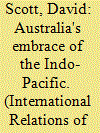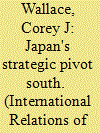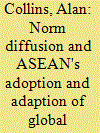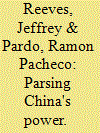|
|
|
Sort Order |
|
|
|
Items / Page
|
|
|
|
|
|
|
| Srl | Item |
| 1 |
ID:
123006


|
|
|
|
|
| Publication |
2013.
|
| Summary/Abstract |
This article argues that the 'Indo-Pacific' has become an increasingly influential term during the last few years within Australian strategic debate. Consequently, the article looks at how the concept of the 'Indo-Pacific' as a region is impacting on Australia's strategic discussions about regional identity, regional role, and foreign policy practices. The term has a strategic logic for Australia in shaping its military strategy and strategic partnerships. Here, the article finds that Australian usage of the term operates as an accurate description of an evolving 'region' to conduct strategy within, but also operates quite frequently (though not inevitably or inherently) as a more contested basis for China-balancing. The article looks closely at four themes: the Indo-Pacific as a term, the rhetoric (strategic debate) in Australia surrounding the Indo-Pacific term, the Indo-Pacific policy formulations by Australia, and the developing Indo-Pacific nature of bilateral and trilateral linkages between Australia, India, and the United States.
|
|
|
|
|
|
|
|
|
|
|
|
|
|
|
|
| 2 |
ID:
123005


|
|
|
|
|
| Publication |
2013.
|
| Summary/Abstract |
Scholars have remarked that the decision-making process in the Association of Southeast Asian Nations (ASEAN) is largely elitist in nature and concentrated within the higher echelon of leadership, with little public participation. Since ASEAN is moving toward community building by the year 2015, questions arise on whether the people are consulted, aware, and support this initiative - which is the focus of this article. The authors argue that increased awareness and knowledge of the public regarding the ASEAN Community initiative will eventually translate into increased support. Against this background, this article analyzes the extent the public in Indonesia, Malaysia, and Singapore are aware of and support the proposed initiative, based on public opinion surveys conducted by the authors in these countries. To support the discussion, this article also employs the Pearson chi-square test to analyze the relationship between public awareness and support for the ASEAN Community.
|
|
|
|
|
|
|
|
|
|
|
|
|
|
|
|
| 3 |
ID:
123008


|
|
|
|
|
| Publication |
2013.
|
| Summary/Abstract |
Tensions between Japan and its neighbors pose a significant problem for the viability of Japan's strategic 'dual hedge' between China and the United States. Japan's response has been to embrace renewed US commitment to the region while initiating comprehensive strategic partnerships in military, economic, and political spheres with nations 'south' of its traditional domain of strategic interest. Strengthened relationships with Southeast Asian nations, India, and Australia may turn out to be crucial for Japan as it will enable Japan to manage its security affairs without having to depart from its long-cultivated maritime security policy, and will enable Japan to continue to pursue a neo-mercantilist economic policy while also supporting the socioeconomic development of other regional players essential for future multipolar balance. Japan's diplomatic activities provide a useful 'strategic contrast' with China that will likely ensure Japan is accepted in the region. Japan's strategic pivot is also domestically sustainable and, therefore, deserves scholarly attention.
|
|
|
|
|
|
|
|
|
|
|
|
|
|
|
|
| 4 |
ID:
123004


|
|
|
|
|
| Publication |
2013.
|
| Summary/Abstract |
This article examines the diffusion of norms from a global actor, the Joint United Nations Programme on HIV/AIDS (UNAIDS), to the Association of Southeast Asian Nations (ASEAN). This entails using three processes of norm diffusion (localization, subsidiarity, and mimetic adoption) to examine and explain the adoption and adaption of global norms in the Association's four ASEAN Work Programmes (AWPs) on HIV/AIDS. In so doing, the article reveals that these different processes can be seen at work in different AWPs. The article also reveals the limitations of the AWPs and hence the lack of a coordinated regional response to the virus.
|
|
|
|
|
|
|
|
|
|
|
|
|
|
|
|
| 5 |
ID:
123007


|
|
|
|
|
| Publication |
2013.
|
| Summary/Abstract |
This article draws on Michael Barnett and Raymond Duvall's power typology to examine Chinese power in Sino-Mongolia and Sino-North Korean relations. Using compulsory, institutional, productive, and structural power to frame these bilateral relations, this article looks at the means by which China obtains power and how it utilizes power in relation to Mongolia and the Democratic People's Republic of Korea. This article also examines Mongolian and North Korean perceptions and responses to Chinese power. Concurrently, the article considers the Barnett/Duvall model's applicability to China's relations with other periphery developing states.
|
|
|
|
|
|
|
|
|
|
|
|
|
|
|
|
| 6 |
ID:
123003


|
|
|
|
|
| Publication |
2013.
|
| Summary/Abstract |
Alliance persistence in the face of the disappearance of mutual threat or the deterioration of mutual threat perceptions between allies comprises the major concern of this article. This article argues that an alliance (whose primary threat-centric rationale has significantly diminished, if not disappeared) persists if two conditions are met: (i) the alliance serves as an essential arrangement for pursuing an 'order insurance strategy' (which is termed in this article as 'alliance for order insurance') and (ii) the allies invest for such benefits with arrangements to ensure alliance preservation against challenges that arise as a result of alliance mismanagement (which is termed in this article as 'insurance for alliance'). To test this argument, this article evaluates the persistence of the United States-Australia alliance in the post-Cold War period. Also, to achieve some basis for falsification, it explores the discontinuation of the United States-New Zealand leg of ANZUS since the mid-1980s and the United States-Philippines alliance during most of the 1990s.
|
|
|
|
|
|
|
|
|
|
|
|
|
|
|
|
|
|
|
|
|